
Chi Serpentis is a solitary star in the Serpens Caput section of the equatorial constellation Serpens. Based upon an annual parallax shift of 14.84 mas as seen from Earth, it is located around 222 light years from the Sun. The star is bright enough to be faintly visible to the naked eye, having an apparent visual magnitude of +5.30.

13 Andromedae, abbreviated 13 And, is a single, blue-white hued variable star in the northern constellation of Andromeda. 13 Andromedae is the Flamsteed designation, while it bears the variable star designation V388 Andromedae. With a typical apparent visual magnitude of around 5.75, it is dimly visible to the naked eye under good seeing conditions. The distance to this star can be directly estimated from its annual parallax shift of 10.9 mas, yielding a range of 300 light years. At that distance, its brightness is diminished by an extinction of 0.13 magnitude due to interstellar dust. The star is moving closer to the Earth with a heliocentric radial velocity of −8 km/s.

56 Arietis is a single, variable star in the northern zodiac constellation of Aries. It has the variable star designation SX Arietis, while 56 Arietis is the Flamsteed designation. This object is visible to the naked eye as a faint, blue-white hued point of light with a baseline apparent visual magnitude of 5.79. The estimated distance to this star is approximately 415 light-years, based on parallax, and it is drifting further away with a radial velocity of +18 km/s.

36 Aurigae is a single variable star located about 910 light years away from the Sun in the constellation Auriga. It has the variable star designation V444 Aurigae, while 36 Aurigae is the Flamsteed designation. This object is visible to the naked eye as a dim, white-hued star with a baseline apparent visual magnitude of 5.71. It is moving further from the Earth with a heliocentric radial velocity of +16 km/s.
42 Camelopardalis is a single star in the constellation Camelopardalis, located roughly 770 light years away from the Sun. It is visible to the naked eye as a faint, blue-white hued star with an apparent visual magnitude of 5.14. The visual magnitude of the star is diminished by an extinction of 0.22 due to interstellar dust. It is moving further from the Earth with a heliocentric radial velocity of 3 km/s. 42 Camelopardalis has a peculiar velocity of 24.4+1.9
−2.1 km/s and may be a runaway star.
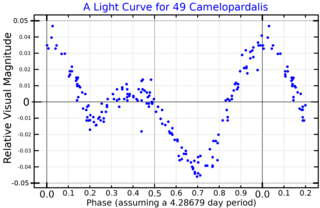
49 Camelopardalis is a variable star in the northern circumpolar constellation of Camelopardalis, located 313 light years from the Sun based on parallax measurements. It has the variable star designation BC Camelopardalis; 49 Camelopardalis is the Flamsteed designation. This star is a challenge to view with the naked eye, having a baseline apparent visual magnitude of 6.50. It is moving away from the Earth with a heliocentric radial velocity of +6.5 km/s.

ET Andromedae is a binary star system star in the northern constellation of Andromeda. It has an apparent visual magnitude of 6.48, placing it at the nominal limit for visibility with the naked eye. The distance to this system can be estimated from its annual parallax shift of 5.42 mas, which yields a value of 602 light years.

V1291 Aquilae is a single star in the equatorial constellation of Aquila. It has a yellow-white hue and is dimly visible to the naked eye with an apparent visual magnitude that fluctuates around 5.65. Based on parallax measurements, it is located at a distance of approximately 278 light years from the Sun. The star it is drifting closer with a radial velocity of −22 km/s.

BX Boötis is a star in the northern constellation of Boötes. It is a dim star near the lower limit of visibility to the naked eye, having a nominal apparent visual magnitude of 6.35. Based upon an annual parallax shift of 10.81 mas, it is located 302 light years away. At that distance, the visual magnitude of the star is diminished by an extinction of 0.13 due to interstellar dust. It is moving closer with a heliocentric radial velocity of −11 km/s.
HR 3082 is a double star in the northern circumpolar constellation of Camelopardalis. It is faintly visible to the naked eye with an apparent visual magnitude of 5.39. The system is moving closer to the Sun with a heliocentric radial velocity of +2.7 km/s. It is currently at a distance of around 323 light years, based upon an annual parallax shift of 10.10±0.24 mas.
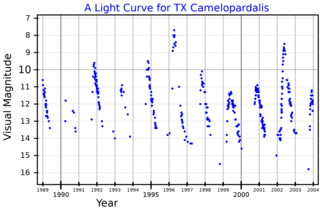
TX Camelopardalis is a Mira-type variable star in the constellation Camelopardalis. It is a classical long period variable star with pulsational period of 558.7 days. Water masers have been observed around the star.

Tau9 Eridani is a binary star in the constellation Eridanus. It is visible to the naked eye with an apparent visual magnitude of 4.63. The distance to this system can be estimated using the parallax method, which yields a value of roughly 327 light years.
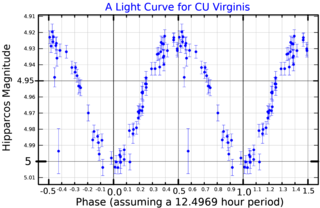
CU Virginis is a single star in the equatorial constellation of Virgo. It has an apparent visual magnitude of 4.99, which is bright enough to be faintly visible to the naked eye. The distance to this star can be estimated from its annual parallax shift of 13.9 mas, yielding a separation of 234 light years.
11 Persei is a single star in the constellation of Perseus, located about 418 light years away from the Sun. It is visible to the naked eye as a dim, blue-white hued star with an apparent visual magnitude of 5.76.
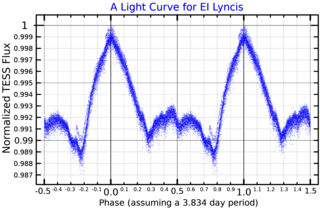
36 Lyncis is a solitary variable star located around 620 light years away from the Sun in the northern constellation of Lynx. It has the variable star designation of EI Lyncis, while 36 Lyncis is the Flamsteed designation. This object is visible to the naked eye as a dim, blue-white hued star with an apparent visual magnitude of 5.30. It is moving further away from the Earth with a heliocentric radial velocity of 21 km/s.

Xi Phoenicis, Latinized from ξ Phoenicis, is a visual binary star system in the southern constellation of Phoenix. It is faintly visible to the naked eye, having an apparent visual magnitude of 5.70. Based upon an annual parallax shift of 14.61 mas as measured from Earth, it is located around 223 light years from the Sun. The system is moving away from the Sun with a radial velocity of about +10 km/s.
QV Andromedae is an Alpha2 Canum Venaticorum variable in the constellation Andromeda. Its maximum apparent visual magnitude is 6.6, so it can be seen by the naked eye under very favourable conditions. The brightness varies slightly following a periodic cycle of approximately 5.23 days.
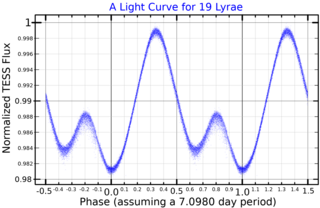
19 Lyrae is a single variable star located approximately 950 light years away from the Sun in the northern constellation of Lyra. It has the variable star designation V471 Lyr, while 19 Lyrae is the Flamsteed designation. This object is just bright enough to be visible to the naked eye, appearing as a dim, blue-white star with a baseline apparent visual magnitude of 5.93. It is moving closer to the Earth with a heliocentric radial velocity of −30 km/s, and may come as close as 167 light-years around 8.5 million years from now.

HD 125248 is a binary star system in the equatorial constellation of Virgo. It has the variable star designation CS Virginis, while HD 125248 is the designation from the Henry Draper Catalogue. This system is dimly visible to the naked eye as a point of light with an apparent visual magnitude that ranges from 5.84 down to 5.95. It is located at a distance of approximately 280 light years from the Sun based on parallax measurements, but is drifting closer with a heliocentric radial velocity of −8 km/s.
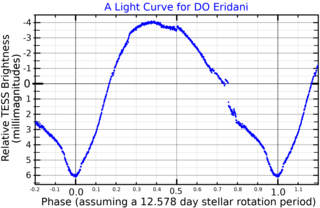
HR 1217 is a variable star in the constellation Eridanus. It has the variable star designation DO Eridani, but this seldom appears in the astronomical literature; it is usually called either HR 1217 or HD 24712. At its brightest, HR 1217 has an apparent magnitude of 5.97, making it very faintly visible to the naked eye for an observer with excellent dark-sky conditions.
















